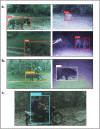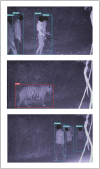Mitigating human-wildlife conflict and monitoring endangered tigers using a real-time camera-based alert system
- PMID: 37854891
- PMCID: PMC10580963
- DOI: 10.1093/biosci/biad076
Mitigating human-wildlife conflict and monitoring endangered tigers using a real-time camera-based alert system
Abstract
The recovery of wild tigers in India and Nepal is a remarkable conservation achievement, but it sets the stage for increased human-wildlife conflict where parks are limited in size and where tigers reside outside reserves. We deployed an innovative technology, the TrailGuard AI camera-alert system, which runs on-the-edge artificial intelligence algorithms to detect tigers and poachers and transmit real-time images to designated authorities responsible for managing prominent tiger landscapes in India. We successfully captured and transmitted the first images of tigers using cameras with embedded AI and detected poachers. Notifications of tiger images were received in real time, approximately 30 seconds from camera trigger to appearing in a smart phone app. We review use cases of this AI-based real-time alert system for managers and local communities and suggest how the system could help monitor tigers and other endangered species, detect poaching, and provide early warnings for human-wildlife conflict.
Keywords: embedded-AI camera-alert systems; endangered species; human–wildlife conflict; poaching; tigers.
© The Author(s) 2023. Published by Oxford University Press on behalf of the American Institute of Biological Sciences.
Figures





References
-
- Appleton MR, et al. 2022. Protected area personnel and ranger numbers are insufficient to deliver global expectations. Nature Sustainability 5: 1100–1110.
-
- Ardoin NM, Bowers AW, Gaillard E.. 2020. Environmental education outcomes for conservation: A systematic review. Biological Conservation 241: 108224.
-
- Carter NH, Linnell JDC.. 2016. Co-adaptation is key to coexisting with large carnivores. Trends in Ecology and Evolution 31: 575–578. - PubMed
-
- Dhanwatey HS, Crawford JC, Abade LAS, Dhanwatey PH, Nielsen CK, Sillero-Zubiri C.. 2013. Large carnivore attacks on humans in central India: A case study from the Tadoba–Andhari Tiger Reserve. Oryx 47: 221–227.
-
- Dinerstein E. 2018. Fighting Illegal Poaching with a Purpose-Built AI Camera. Intel Corp.

